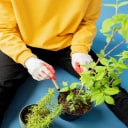Japanese Red Maple Bonsai – Shindeshojo Starter Kit
This starter kit includes all the essential components for maintaining and pruning your bonsai tree. Ideal for the beginner or hobbyist looking to add a new tree to their collection.
Set includes: Japanese Red Maple Bonsai
– Large Japanese Red Maple Bonsai
– Bonsai Pocket Guide: A Beginner’s Journey
– Traditional Thinning Shear
– 9″ Humidity Tray
– 1.5 mm Aluminum Training Wire (10 ft)
– Bonsai Fertilizer 3oz
Bonsai Specifications: Japanese Red Maple Bonsai
– Bonsai Tree Age: 7-9 Years Old
– Height: 11″ – 14″ Tall Potted
– Pot: 8″ Ceramic Bonsai Pot
– Classification: Broadleaf Deciduous
– Level: Intermediate
Japanese Red Maple Bonsai
The Japanese Red Maple features red leaves during the cooler months and green leaves during the warmer months. Japanese Maple bonsai trees, or Acer Palmatum, are highly prized as bonsai due to their unique leaves. Japanese Maple Bonsai trees are deciduous and will lose all of their leaves during winter.
Japanese maple trees are easy to take care of. However, due to their deciduous nature, we recommend them for intermediate and advanced enthusiasts.
During the warmer months, leaf scorch may occur for this species of maple if exposed to Heat, Dry Winds, Water Quality – High (Alkaline) pH of water (over 6.5), and Salt. Trees may arrive with some leaf burn which is a normal process of growth and leaf rotation. The bonsai can be defoliated during the summer months for desired foliage. Pot may vary depending on availability. Bonsai tree shape may vary from shown.
Japanese Red Maple Bonsai
| Pruning Tips: Maple bonsai trees can be trained easily using the clip and grow method. Maple bonsai trees back bud at the nodes. To keep internodes shorter, prune back longer internodes to reduce them over time. Maples will also back bud to the trunk if you do heavy branch cutting. We recommend waiting for woody growth prior to cutting back to ensure bud growth. Maple bonsai branches can be brittle. Take care if you are applying wire. A good technique for training maple bonsai is to use guy wire along with the clip and grow technique. |
|
|
|
|
| Fertilizing: We recommend fertilizing your bonsai tree every month with a bonsai fertilizer. Time release granules are the easiest to use and can be added every season. Reduce the amount of fertilizer during the winter. Take care to not over-fertilize as this can cause your leaves to burn or grow too leggy. |
|
|
|
|
 |
Lighting: Maple Bonsai trees thrive best with natural sunlight. We recommend filtered natural sunlight. If placed in full sun, take care to manage your watering to prevent your tree from drying out. Also, full sunlight and warmer conditions can lead to some leaf burn. |
|
|
|
| Temperature Requirements: Maples are quite hardy to many climates. Due to their deciduous nature, the tree will go into dormancy during the fall / winter and lose all of its leaves. Sprouts and new growth will appear in the spring. |
|
|
|
|
| Watering Requirements: Maple bonsai trees require moderate watering. We recommend using a soft spray to soak the soil. Ensure that water penetrates not only the topsoil but also into the roots by checking that draining is occurring on the bottom of the pot. Keep the Maple moist at all times. |
|
|
|
|
| Repotting: Maple bonsai trees can be repotted during spring and fall for highest success rates. Avoid winter repotting as colder temperatures will make it harder for roots to recover. During repotting, we recommend trimming off older roots to promote new growth. After repotting, place tree in a shaded area for 2-3 weeks prior to placing back in full or partial sun. Maples prefer more acidic soil. |
|
|
|
|
 |
Outdoor: Maple bonsai trees thrive best in outdoor conditions. During the winter, trees can be overwintered to protect from freezing. |
Japanese Red Maple Bonsai











Reviews
Clear filtersThere are no reviews yet.